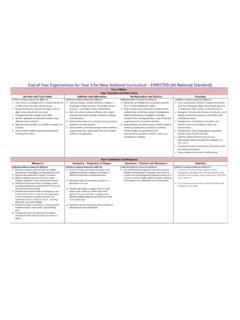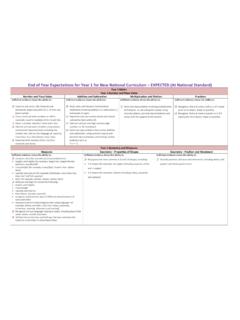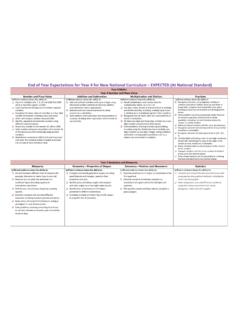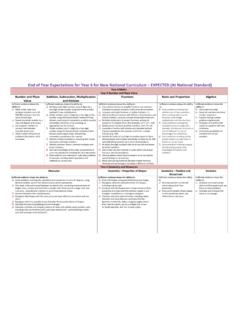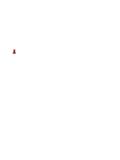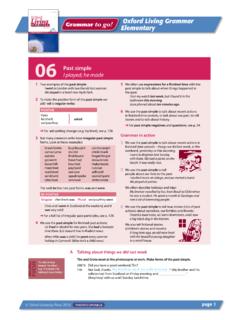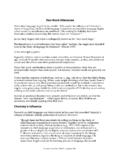Transcription of End of Year Expectations for Year 5 for New National ...
1 End of Year Expectations for Year 5 for New National curriculum expected (At National Standard) Year 5 Maths Year 5 Number and Place Value Number and Place Value Addition and Subtraction Multiplication and Division Fractions Sufficient evidence shows the ability to: Read, write, order and compare numbers to at least 1 000 000 and determine the value of each digit count forwards or backwards in steps of powers of 10 for any given number up to 1 000 000. Interpret negative numbers in context, count forwards and backwards with positive and negative whole numbers, including through zero.
2 Round any number up to 1 000 000 to the nearest 10, 100, 1000, 10 000 and 100 000. Solve number problems and practical problems that involve all of the above. Read Roman numerals to 1000 (M) and recognise years written in Roman numerals. Sufficient evidence shows the ability to: Add and subtract whole numbers with more than 4 digits, including using formal written methods (columnar addition and subtraction). Add and subtract numbers mentally with increasingly large numbers. Use rounding to check answers to calculations and determine, in the context of a problem, levels of accuracy.
3 Solve addition and subtraction multi-step problems in contexts, deciding which operations and methods to use and why. Sufficient evidence shows the ability to: Identify multiples and factors, including finding all factor pairs of a number, and common factors of two numbers. Know and use the vocabulary of prime numbers, prime factors and composite (nonprime) numbers. Establish whether a number up to 100 is prime & recall prime numbers up to 19. Multiply numbers up to 4 digits by a one- or two-digit number using a formal written method, including long multiplication for two-digit numbers.
4 Multiply and divide numbers mentally drawing upon known facts. Divide numbers up to 4 digits by a one-digit number using the formal written method of short division and interpret remainders appropriately for the context Multiply and divide whole numbers and those involving decimals by 10, 100 &1000. Recognise and use square numbers and cube numbers, and the notation for squared (2) and cubed (3). Solve problems involving multiplication and division including using their knowledge of factors and multiples, squares and cubes. Solve problems involving addition, subtraction, multiplication and division and a combination of these, including understanding the meaning of the equals sign.
5 Solve problems involving multiplication and division, including scaling by simple fractions and problems involving simple rates. Sufficient evidence shows the ability to: Compare and order fractions whose denominators are all multiples of the same number. Identify, name and write equivalent fractions of a given fraction, represented visually, including tenths and hundredths. Recognise mixed numbers and improper fractions and convert from one form to the other & write mathematical statements > 1 as a mixed number[2/5 + 4/5 = 6/5 = 1 1/5 ]. Add and subtract fractions with the same denominator and denominators that are multiples of the same number.
6 Multiply proper fractions and mixed numbers by whole numbers, supported by materials and diagrams. Read and write decimal numbers as fractions [for example, = 71/100]. Recognise and use thousandths and relate them to tenths, hundredths and decimal equivalents. Round decimals with two decimal places to the nearest whole number and to one decimal place. Read, write, order & compare numbers with up to three decimal places. Solve problems involving number up to three decimal places. Recognise the percent symbol (%) and understand that percent relates to number of parts per hundred , write percentages as a fraction with denominator 100, & as a decimal.
7 Solve problems which require knowing percent & decimal equivalents of 1/2, 1/4 , 1/5 , 2/5 , 4/5 and those fractions with a denominator of a multiple of 10 or 25. Year 5 Geometry and Measures Measures Geometry Properties of Shapes Geometry Position and Movement Statistics Sufficient evidence shows the ability to: Convert between different units of metric measure (for example, kilometre and metre; centimetre and metre; centimetre and millimetre; gram and kilogram; litre & millilitre). Understand and use approximate equivalences between metric units and common imperial units such as inches, pounds and pints.
8 Measure and calculate the perimeter of composite rectilinear shapes in centimetres and metres. Calculate and compare the area of rectangles (including squares), and including using standard units, square centimetres (cm2 ) and square metres (m2 ) and estimate the area of irregular shapes. Estimate volume [for example, using 1 cm3 blocks to build cuboids (including cubes)] and capacity [for example, using water]. Solve problems involving converting between units of time. Use all four operations to solve problems involving measure [for example, length, mass, volume, money] using decimal notation, including scaling.
9 Sufficient evidence shows the ability to: Identify 3-D shapes, including cubes and other cuboids, from 2-D representations. Know angles are measured in degrees: estimate and compare acute, obtuse and reflex angles. Draw given angles, and measure them in degrees ( ). Identify: angles at a point and one whole turn (total 360 ) angles at a point on a straight line & 1/2 a turn (total 180 ) and other multiples of 90 . Use the properties of rectangles to deduce related facts and find missing lengths and angles distinguish between regular and irregular polygons based on reasoning about equal sides and angles.
10 Sufficient evidence shows the ability to: Identify, describe and represent the position of a shape following a reflection or translation, using the appropriate language, and know that the shape has not changed. Sufficient evidence shows the ability to: Solve comparison, sum and difference problems using information presented in a line graph. Complete, read and interpret information in tables, including timetables. Year 5 Reading Word Reading Comprehension Sufficient evidence shows the ability Fluently and automatically read a range of age-appropriate texts from the following: modern fiction and those from our literary heritage; books from other cultures; myths, legends and traditional stories; poetry; plays; non-fiction and reference or text books.
